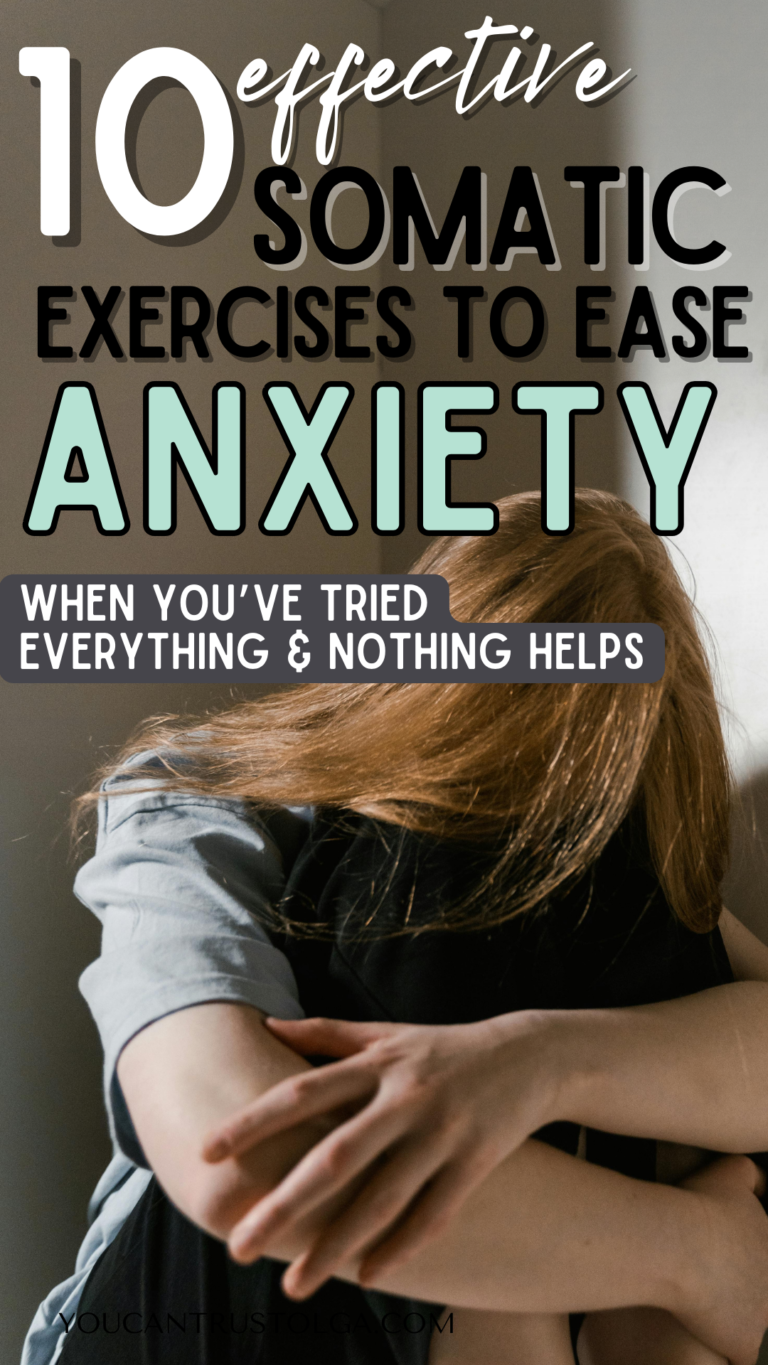If you ever experienced anxiety and panic attacks, you know how overwhelming it can be. Not only it is uncomfortable and scary, but it also takes you away from LIFE.
At moments like this, your attention focuses just on the inner turmoil, looking for relief or some kind of resolution.
All your mental energy is directed inward and you find yourself trapped in the cyclone of fear and discomfort.
Here’s what is important to understand:
Anxiety and panic attacks live IN THE BODY. They are physical.
Meaning most conventional coping mechanisms might miss the mark. We need something different – something that targets THE BODY-MIND CONNECTION.
Somatic therapy is that.
It offers a more grounded path to calm.
Somatic exercises emphasize the connection between the mind and body. They use movement + body awareness to release tension and reorganize your nervous system.
In this article, I offer you ten PROVEN somatic exercises that will alleviate the grip of anxiety and panic for you.
These exercises can be your ANCHOR, helping you bring your mental and physical sensations to the original order.

What is somatic therapy
Somatic therapy is a therapeutic technique that focuses on the MIND-BODY CONNECTION to bring about healing.
It operates on the principle that trauma, stress, and anxiety can manifest not only mentally but also physically, in the form of muscle tension, shallow breathing, and other bodily symptoms.
Somatic Therapy is the approach that blends physical movement, deep breathing, and mindfulness practices to release tension and pent-up emotions.
Its goal is to return your body’s ability to self-regulate to a state of balance.
Anxiety and somatic therapy
Somatic therapy will help you to manage anxiety symptoms by focusing directly on the body.
It will teach you to recognize the physical sensations linked to anxiety and identify triggers and patterns.
It will provide IMMEDIATE symptom relief (less muscle tension, slower breathing, etc), and LONG-TERM (like stress resilience).
By doing somatic practices consistently (like making them a part of your morning routine, for example) you can regulate your emotional balance, so you don’t fluctuate a lot and avoid experiencing extreme emotions in general.
They will also teach you to stay present and reduce overwhelming thoughts, and worries.

somatic exercises for anxiety and panic attacks
That being said, here are ten somatic exercises that have proven to be effective in easing anxiety and panic attacks.
#1 Grounding
Grounding exercises reconnect you with the present moment.
- Begin by standing straight, feet shoulder-width apart.
- Close your eyes, and slowly shift your weight from one foot to the other, noticing the subtle adjustments your body makes to maintain balance.
- Engage all your senses by naming three things you can hear, see, feel, and smell.
This simple act shifts your focus away from racing thoughts, grounding you in the here and now.
#2 Belly Breathing
Calm your nervous system with belly breathing.
- Find a comfortable seated position and place one hand on your chest and the other on your belly.
- Inhale deeply through your nose, feeling your abdomen expand and imagining you’re filling a balloon in your stomach.
- Exhale slowly through pursed lips, noticing the downward motion of your hand as you release the breath.
This type of breathing helps to lower your heart rate and signal to your body that it’s time to relax.

#3 Progressive Muscle Relaxation
Progressive muscle relaxation is a somatic technique that involves tensing and then relaxing each muscle group in your body.
- Start by scrunching your toes tightly for a few seconds, then release.
- Move up to your calves, thighs, and so on, until you’ve reached your facial muscles.
- Focus on the contrast between tension and relaxation, allowing your body to acknowledge and then release the buildup of stress.
#4 Hug Yourself
The power of touch is remarkable. Just try it for yourself. It only takes a minute.
- Standing or sitting, wrap your arms around your body as if you’re giving yourself a hug.
- Take note of the warmth and pressure against your chest, which can trigger the release of oxytocin, a hormone associated with feelings of safety and calm.
- Hold the hug for a few deep breaths, and feel the tension melt away.

#5 Body Scan Meditation
Body scan meditation directs your attention to various parts of your body, noticing any areas of tension or discomfort without judgment.
- Sit or lie down in a comfortable position.
- Close your eyes and take a few deep breaths.
- Notice any sensations or tension in your feet.
- Breathe into any tightness and let it soften.
- Shift your attention to your ankles, calves, and thighs.
- Release any discomfort with each breath.
- Move your focus to your hips and lower back.
- Focus on your stomach and chest.
- Relax any tightness and feel the rise and fall of your breath.
- Bring your attention to your shoulders, arms, and hands.
- Notice any tightness in your neck and jaw.
- Relax these areas with your breath.
- Relax your face, brow, and jaw.
- Let your whole head feel light and at ease.
- Take a moment to feel your entire body.
- Notice how it feels after the scan.
- Take a few deep breaths and slowly open your eyes when ready.
This exercise can help you become more aware of how your body responds to stress and learn to release areas of tightness.
#6 The Releasing Sigh
A deep, audible sigh can be incredibly cathartic.
- Take a deep breath in through your nose, expand your belly, and then exhale with an audible sigh, releasing any physical and emotional tension.
This exercise stimulates the vagus nerve, which can help regulate your heart rate and induce a sense of relaxation.
#7 Flowing Body Movements
- To practice flowing body movements, stand with your feet shoulder-width apart.
- Begin to move your body in any way that feels natural — swaying side to side, gently bouncing, rolling your shoulders, or shaking your arms.
The goal is to invite fluidity and ease into your physical experience, disrupting the rigidity that often accompanies anxiety.
RELATED READING
#8 The Somatic Play
Engage in activities that encourage playfulness and creativity, such as dancing, drawing, or playing an instrument.
By allowing your body to express itself in non-verbal ways, you can release pent-up energy and interrupt anxious thought patterns.
The key is to immerse yourself in the experience and enjoy the process WITHOUT JUDGMENT.
#9 Pretend Physical Therapy
This somatic exercise involves mimicking physical therapy-type movements.
For instance, slowly bend and straighten your fingers, rotate your wrists, or roll your ankles.
This deliberate, gentle movement helps ground you in your body and engage with the present moment, providing a much-needed break from anxious thoughts.
#10 Vibrational Release
Vibrational release involves creating gentle vibrations throughout the body to shake off tension.
- Start by bouncing lightly on the balls of your feet, gradually increasing the intensity until your whole body feels the vibrations.
- Imagine you’re a tree in the wind, swaying with an invisible force that loosens your trunk and limbs.
- After a minute or so, gradually slow down and come to a stop, breathe deeply, and notice how you feel.
Incorporating somatic exercises into your daily routine can significantly reduce the impact of anxiety and help you manage panic attacks effectively.
Remember, these exercises are not a one-size-fits-all solution, but a toolkit for you to explore your inner landscape and find the methods that resonate with you.





